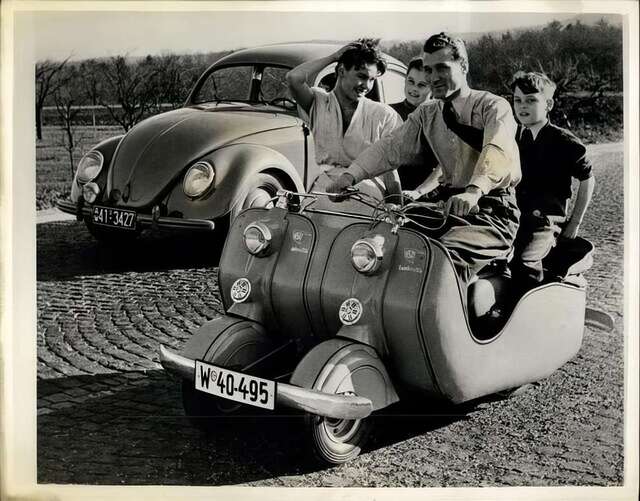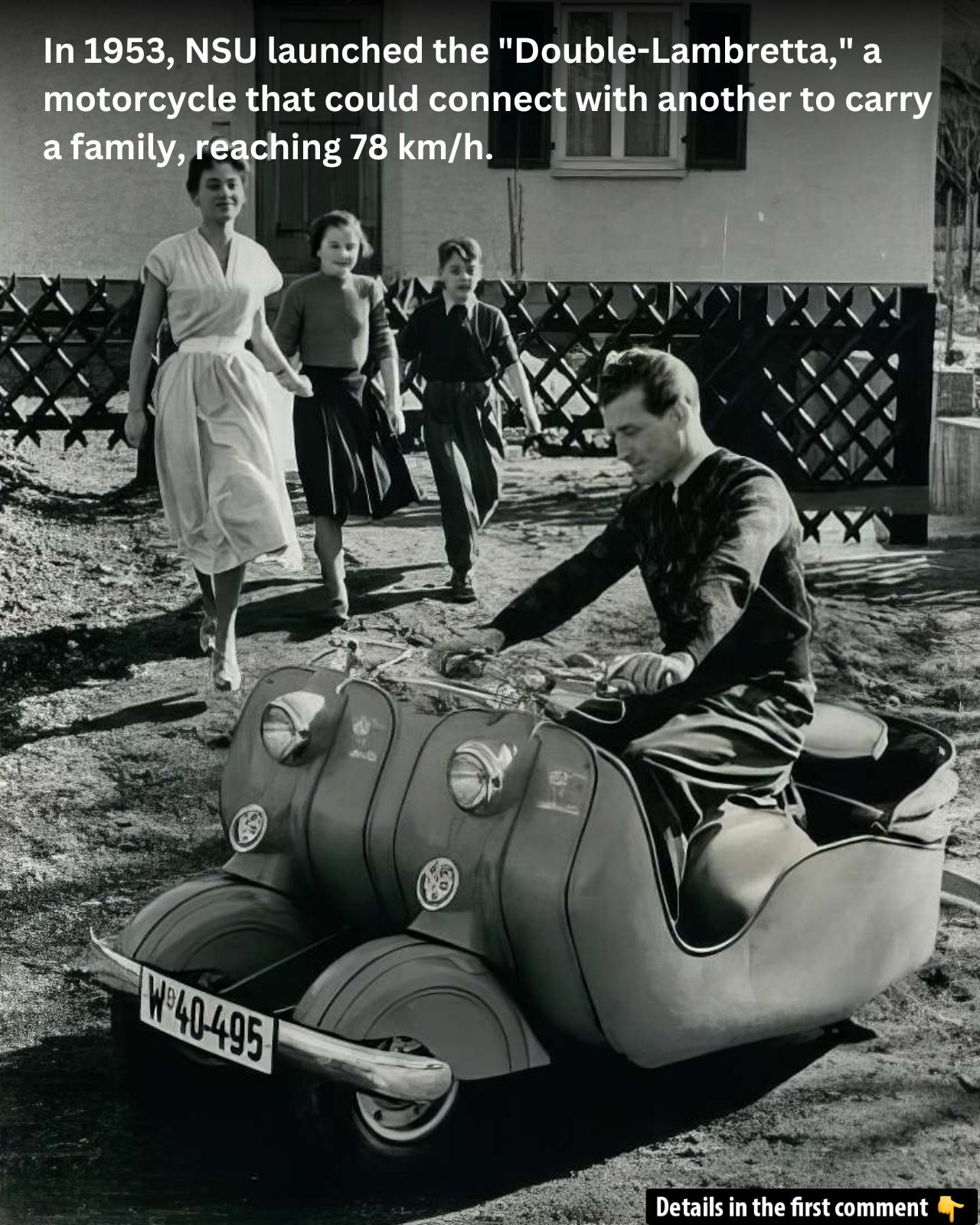In the early 1950s, amid a period of post-war economic recovery in Germany, the NSU factory in Düsseldorf unveiled a unique transportation innovation—the NSU Double-Lambretta. This small motorcycle, which could transform into a family vehicle, captured the imagination of the public and offered a glimpse of how the world of personal mobility was evolving. With its combination of style, practicality, and innovative design, the Double-Lambretta quickly became a standout model in Germany’s burgeoning scooter market.
NSU’s Journey into the Post-War Motorcycle Market
The rise of motor scooters in post-war Germany coincided with the country’s efforts to rebuild after the devastation of World War II. The demand for affordable, efficient transportation soared as many people sought new ways to commute in a rapidly changing society. At the forefront of this movement was the Italian scooter, the Lambretta, produced by the Innocenti company. NSU, a German manufacturer based in Düsseldorf, saw an opportunity to capitalize on this trend and entered into a licensing agreement with Innocenti to produce their own version of the Lambretta.
NSU’s version of the Lambretta was first introduced at the 1950 Frankfurt Trade Fair, where it quickly gained attention for its sleek design and fuel-efficient performance. Targeted primarily at women, the Lambretta’s low fuel consumption—just 2 liters per 100 kilometers—made it particularly appealing during a time of scarce resources. The scooter’s commercial success was rapid, with NSU producing 1,100 units in August 1951 alone, a remarkable feat for the young company. By the time production ended in 1957, nearly 189,000 units had been manufactured.
Video
Watch the video to explore the 1955 NSU Lambretta 150! Don’t miss this look at the classic motorcycle and its features.
Design and Features: A Motorcycle with Family Appeal
In 1953, NSU took a bold step with the introduction of the Double-Lambretta. While originally designed as a small, efficient motorcycle for young couples, the innovation behind this vehicle was its versatility. The Double-Lambretta could be connected with another Lambretta to create a makeshift “family car” of sorts. When joined together, the two scooters could accommodate two adults and two children, offering a simple yet effective solution for families looking for affordable transportation.
The Double-Lambretta achieved impressive speeds of up to 78 km/h, making it an ideal vehicle for urban commutes, while its fuel efficiency of 3.4 liters per 100 kilometers ensured that it was also economically sustainable. At the time, the concept of a modular scooter that could be expanded to accommodate more passengers was a revolutionary idea, showcasing NSU’s ability to think beyond traditional motorcycle design.
The NSU Lambretta’s Commercial Success
The introduction of the Double-Lambretta was part of a larger strategy by NSU to dominate the growing scooter market in Germany. In addition to its practical design, NSU’s Lambretta models quickly gained popularity because of their affordability, performance, and ease of use. Early marketing campaigns targeted women, with the scooter marketed as a convenient and stylish mode of transportation for young, independent women.
The Lambretta was widely embraced in post-war Germany, where many families could not yet afford automobiles. The scooter offered an affordable alternative that still allowed for mobility and freedom. As the popularity of the Lambretta grew, so too did the demand for even more stylish and functional models. In response, NSU introduced the NSU Luxury Lambretta, an upgraded version of the original scooter, which included a two-tone paint job, polished aluminum accents on the rear panels, a front bumper bar, and even a parking light that could be controlled from the dashboard.
By the mid-1950s, the success of the Lambretta had already reached impressive heights. The company was producing thousands of units annually, and its presence on the streets of Germany had become ubiquitous. The introduction of the Double-Lambretta added a new dimension to the brand’s appeal, helping NSU to solidify its position as one of the leading manufacturers in the scooter market.
The Evolution of the NSU Lambretta: From Basic to Luxury
While the initial Lambretta models remained true to Innocenti’s original design, NSU’s engineers soon began making their own improvements. These innovations were intended to not only enhance the performance of the scooters but also to make them more stylish and appealing to a wider audience. The introduction of the NSU Luxury Lambretta was a key moment in this evolution. The luxury model featured sleek details such as two-tone paint, which gave it a more polished and high-end look, and aluminum accents that added a modern touch to the scooter’s design.
Other upgrades included a front bumper bar and a unique parking light that could be controlled from the dashboard, making the scooter more practical for urban living. These features helped the NSU Lambretta to stand out from its competitors and appeal to a growing market of consumers who wanted a stylish, practical, and affordable vehicle.
The evolution of the Lambretta design was a testament to NSU’s commitment to innovation and their ability to anticipate the needs of the market. The company’s willingness to enhance the scooter’s design over time ensured that the Lambretta remained relevant, even as new competitors entered the market.
The Legacy of the Double-Lambretta

The NSU Lambretta remains an iconic piece of transportation history, representing a unique moment in the post-war scooter boom. While the Double-Lambretta never reached the mass appeal of larger cars, it showcased the creative thinking and adaptability of NSU, which sought to offer affordable transportation that could meet the needs of families. The ability to connect two Lambrettas and transform them into a functional family vehicle was a precursor to the modular, customizable vehicles we see in the modern automotive industry.
Although production ceased in 1957, the legacy of the NSU Lambretta lives on. The scooter became a symbol of affordable mobility during a time of economic hardship, and its commercial success helped pave the way for future innovations in transportation. Today, the Lambretta is remembered fondly by vintage scooter enthusiasts and collectors, who continue to celebrate its place in the history of motorized transportation.
Video
Watch the video to see the ’80s Lambretta that holds four FIM speed records! Don’t miss this impressive look at its speed and performance.
Conclusion: A Vision of the Future, Then and Now
Looking back at the NSU Double-Lambretta of the 1950s, it’s easy to see how ahead of its time it was. The combination of sleek design, efficiency, and versatility made it a groundbreaking vehicle in an era when most families couldn’t afford a car. While the Double-Lambretta may no longer be in production, its legacy continues to influence modern vehicle design, and it remains an iconic symbol of innovation and practicality. The ingenuity behind this vehicle highlights how a small, forward-thinking company could shape the future of personal transportation, paving the way for new ideas and possibilities in the automotive industry.



